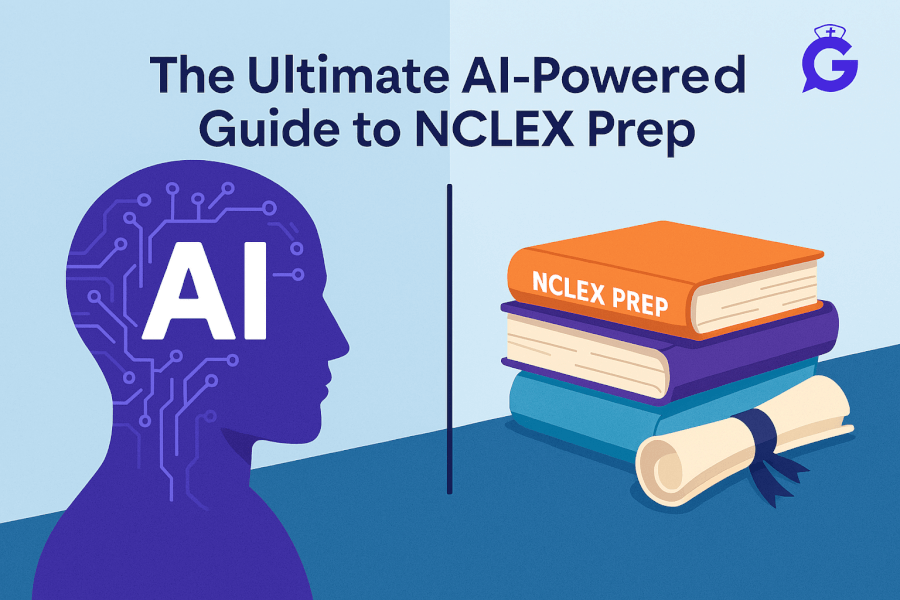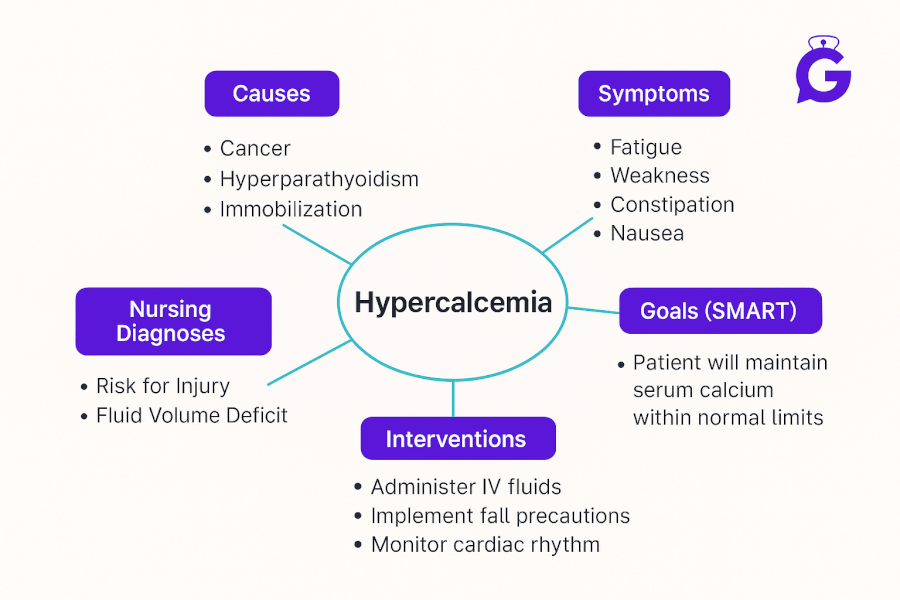You’re probably here because you searched for “AI in nursing education” or “AI for nursing students.” You’re in the right place. This is a comprehensive guide to AI and nursing -what it can do for your day-to-day, what to avoid, and how GoodNurse is advancing an AI nursing tutor that helps you study smarter without cutting corners.
By the end of this guide you’ll have a working system: a safe AI setup, prompts that build real care plans, pharmacology sheets you can actually study from, and NGN practice that shows whether your actions changed the outcome. No fluff - just steps you can run tonight.
What you’ll get in this Ultimate Guide
- The line between helpful and harmful AI: What AI Is Good/Not Good For
- A safe, repeatable setup (no PHI, syllabus-friendly): Safe Workflows (HIPAA/FERPA)
- A realistic daily/weekly study system: Core Study System
- Copy-paste Prompt Packs for care plans, pharm, NGN, and notes: Prompt Packs (see the full library: AI Prompt Library (2025))
- Step-by-step workflows you can follow tonight:
— Care-Plan Workflow · Pharmacology Workflow · NGN Practice Workflow - How to choose the right tool for your budget and privacy needs: Decision Criteria + Quick Picks (compare options: Best AI Apps for Nursing Students (2025))
- Direct routes to high-yield practice: NGN Case Studies (2025): 25 Free Examples with Answers
🎯 Free NCLEX quiz!
Test your knowledge—new quizzes added weekly!
What AI Is Good (and Not Good) For
Great for
- Structuring: turning messy notes into tables/checklists that grade cleanly.
- Summarizing: compressing long readings into key points, definitions, mnemonics.
- Rehearsal: generating NGN-style items (bow-tie, matrix) for reasoning practice.
- Personalization: matching explanations to ADN/BSN level and your rubric.
Not great, yet. But it'll get there very soon
- Authoritative facts (it can “sound right” and can still be wrong). Cross-check with text/drug guide.
- Clinical shortcuts (never replaces your validation, scope, or policy).
- Privacy (never paste PHI or classmate data).
Faculty tip: Ask for format first (“two tables + bullets”), then content. Structure cuts your editing time by half.
Safe Workflows (HIPAA/FERPA Basics)
- No PHI. De-identify completely: no names, dates, room numbers, or unique details.
- Cite and verify. Ask AI to list sources; then verify against your textbook, syllabus, or drug reference.
- Declare level & rubric. Start prompts with your program level and paste rubric bullets.
- Keep drafts auditable. Save your prompts/outputs. You should be able to defend every line.
If you’re new to reading cases efficiently, start with How to Read NGN Case Stems (2025): Clinical Judgment Strategy Guide and tie your practice to NGN Case Studies (2025): 25 Free Examples.
Core Study System (Daily & Weekly Loop)
Daily (20–30 min)
- 1 short NGN item or case (bow-tie or matrix).
- 1 pharm sheet or care-plan micro-task.
- 2–3 active-recall questions from your notes.
Weekly (60–120 min)
- One category focus (e.g., Physiological Adaptation). Do 3–5 cases, then redo misses.
- Convert the week’s slides into a two-page study guide using the note workflow below.
- Update your Action → Parameter mini-grid (what you do and how you’ll know it worked).
For pacing, see How Long Should I Study for the NCLEX? and weight your practice by NCLEX Categories & Subcategories.
Prompt Packs (Care Plans, Pharm, NGN, Notes)
Grab the ready-to-paste prompts here:
AI Prompt Library for Nursing Students (2025)
Highlights from the library:
- Care plans (NANDA) with SMART goals, four interventions + rationales, and evaluation criteria.
- Pharm sheets (mechanism, adverse effects, interactions, teaching) + two NCLEX-style questions.
- NGN item generators (bow-tie, matrix/grid) with rationales and partial-credit notes.
- Lecture → study guide conversion + spaced repetition plan.
Care-Plan Workflow (Professor-Approved)
1) Start with your own reasoning.
State the priority (“Impaired Gas Exchange from pulmonary edema”) before prompting.
2) Prompt for structure.
“Draft an RN-level NANDA care plan for [problem] related to [etiology] as evidenced by [cues]. Include 2 SMART goals, 4 nursing interventions with evidence-backed rationales, and evaluation criteria for 24–48h. Output as a two-column table (Plan / Notes for Charting). Level: [ADN/BSN term].”
3) Add the clinical proof.
“From this plan, identify the two highest-priority actions that change physiology first and the two parameters that will improve in 10–30 minutes. One-line rationale per pair.”
4) Compare to known patterns.
If you’re unsure, scan Med-Surg / Physiological Adaptation Case Studies (2025) and Maternal–Newborn Case Studies (2025) for common Action → Parameter pairs.
🥇Voted #1 Nursing Study Tool.
Personalized AI Tutor + Instant Answers to All Your Questions. 100% Money Back Guarantee!
Care-plan checklist
- Priority named in 7–12 words.
- SMART goals truly measurable/time-bound.
- Interventions include what, why, how to evaluate.
- Parameters can change today (SpO₂, MAP, UOP—not A1C in 3 months).
Pharmacology Workflow (Mechanisms → Safety → Recall)
1) Build the sheet.
“Create a concise pharmacology sheet for [drug/class]: mechanism, indications, high-yield adverse effects, contraindications, interactions, nursing considerations, patient teaching. Add 2 NCLEX-style questions with rationales. Use headings + bullets.”
2) Compare/contrast similar classes.
“Make a 4-column table comparing ACE inhibitors vs ARBs: mechanism, adverse effects (cough vs angioedema risk), nursing considerations, patient teaching.”
3) Generate mnemonics (safely).
“Propose two professional mnemonics for [drug/class] emphasizing black-box warnings and must-not-miss adverse effects.”
Tie-back practice: NGN Pharmacology Case Studies (2025).
NGN Practice Workflow (Bow-Tie, Matrix/Grid)
Bow-Tie generation
“Create a bow-tie item on [clinical problem] with trend data (vitals, labs, meds). Include one correct problem, 4 actions (label the two best), and 4 parameters (label the two best). Add a key and 3–5 sentence rationale.”
Matrix/Grid generation
“Create a matrix/grid on [topic] with rows for cues, actions, rationales and columns for select relevant. Limit choices to 3–5 per row. Include partial-credit scoring guidance and answer key.”
Strategy refreshers: NGN Bow-Tie Items (2025) and NGN Matrix/Grid Items (2025).
Faculty tip: Your two actions should change physiology (oxygenation, perfusion, neuro) and your two parameters should prove it worked soon. That’s how NGN partial credit stacks up.
Note-Making & Spaced Repetition (Lecture → Mastery)
Lecture → Study-Guide prompt
“Convert these lecture bullets into a two-page study guide with: key terms (one-line defs), must-know formulas, mini-tables for normal ranges, and three exam-style questions with rationales. Level: [course/term]. Use headings, bullets, tables.”
Spaced repetition prompt
“Turn this guide into 20 active-recall flashcards and schedule them for 4 weeks (days 1, 3, 7, 14, 28). Output a printable checklist.”
When lab ranges/ABGs appear in your notes, bookmark our upcoming Lab Values & Diagnostic Interpretation series, and meanwhile review Physiological Adaptation: Key Concepts & Mnemonics.
Choosing a Tool (Decision Criteria + Quick Picks)
Decision criteria
- Structure quality (tables/checklists), prompt history, export (doc/pdf).
- Privacy posture and an easy de-identify workflow.
- Mobile access for on-the-go study.
- Stable pricing and student discounts.
For current options and a side-by-side, see Best AI Apps for Nursing Students (2025).
Quick picks by job-to-be-done
- Care-plan heavy term: Tool with strong tables/checklists and clean export.
- Pharm focus: Tool that formats citations and bullets reliably.
- NGN prep: Tool with template saving and low “reasoning drift.”
Common Mistakes (and How to Fix Them)
1) Treating AI as an answer engine
Fix: Use it for format + rehearsal, then verify content with your text.
2) Over-selecting on NGN matrices
Fix: State the single priority first; only select cues/actions that support it. Practice here: Matrix/Grid Items.
3) Goals without evaluation
Fix: Pair every action with a parameter you can measure in 10–30 minutes.
4) Copy-pasting PHI
Fix: De-identify ruthlessly. Keep prompts generic and policy-safe.
5) Studying only by reading
Fix: Convert notes to questions, then practice NGN cases:
FAQs
Is using AI allowed in nursing school?
Policies vary. Many programs allow AI for drafting/structuring but require original work and proper citation/verification. When in doubt, ask your faculty and follow the syllabus.
Can I paste patient details into an AI?
No—avoid PHI entirely. Use generic, de-identified descriptions.
What’s the fastest way to see results with AI?
Start with format: care-plan tables, pharm sheets, and NGN item templates. Then practice daily with small sets and verify everything.
How do I avoid hallucinations?
Constrain outputs (“two tables + bullets”), ask for citations, and check against your textbook/drug guide.
Should I call the provider or act first?
If you can safely stabilize now (oxygen, positioning, fluids), do that—then notify. See Bow-Tie Items for examples.
How do I build endurance for NGN?
Use the daily micro-loop + weekly long block. Rotate categories (med-surg, OB, peds/psych). Track your Action → Parameter pairs.






